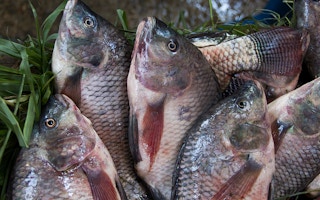An emerging viral disease observed in both wild and farmed tilapia could impact global food security and nutrition if biosafety measures are not introduced, the UN Food and Agriculture Organization (FAO) and other organisations have warned.
The warning appeared in a special alert issued by FAO (May 26). Tilapia lake virus (TiLV) was first detected in Israel in 2009, but was only confirmed as a new disease in 2014. Cases have since been reported in other parts of the world.
“All countries culturing tilapia and especially those translocating live tilapia should be vigilant about the disease and take appropriate risk management measures to reduce the likelihood of imported stocks being infected with TiLV,” Melba Reantaso, aquaculture officer at the FAO, tells SciDev.Net.
Tilapia is a common name for hundreds of species of the tilapiine cichlid fish, and its name comes from the cichlid genus Tilapia. It is the most popular farmed fish in the world, after carp and salmon.
According to research, TiLV has been reported in five countries so far: Colombia, Ecuador, Egypt, Israel and Thailand. Outbreaks in Thailand have wiped out 90 per cent of tilapia stocks.
“
All countries culturing tilapia and especially those translocating live tilapia should be vigilant about the disease.
Melba Reantaso, UN Food and Agriculture Organization
TiLV is part of the Orthomyxoviridae family of viruses, which is related to the anaemia virus that has heavily damaged the salmon farming industry. It is not known to infect humans.
Fish infected with TiLV often display sluggishness, lesions of the skin, eye abnormalities and lens opacity. However, there are still knowledge gaps, such as whether passive carriers of the infection can transmit the virus and whether infections through frozen tilapia products are possible.
Vishnumurthy Mohan Chadag, a senior scientist at WorldFish, an international non-profit research organisation, tells SciDev.Net that countries vulnerable to the TiLV virus need to put in place monitoring and surveillance strategies.
“Building awareness about TiLV in all sectors of the value chain is also important,” says Chadag, with special attention given to small-scale farmers with limited access to knowledge and information.
At the international level, mobilisation is already underway between various stakeholders to assist affected countries and get them to adopt biosecurity measures that include requirements to report unusual fish mortality and restrictions on the movement of live fish. Efforts are also underway to develop a vaccine.
China, India and Indonesia are actively monitoring for TiLV. In Israel, an epidemiological survey is expected to determine factors influencing low survival rates and mortalities.
According to FAO, tilapia is among the top aquaculture species, in terms of volume, that provide food, jobs and earnings — from domestic trade and export — for millions of people, including many smallholders.
China, Indonesia and Egypt are the three leading aquaculture producers of tilapia, a fish deemed to have great potential for expansion in sub-Saharan Africa. In 2015, world tilapia production, from both aquaculture and capture, amounted to 6.4 million tonnes valued at US$9.8 billion.
This piece was produced by SciDev.Net’s Asia & Pacific desk.
This article was originally published on SciDev.Net. Read the original article.










